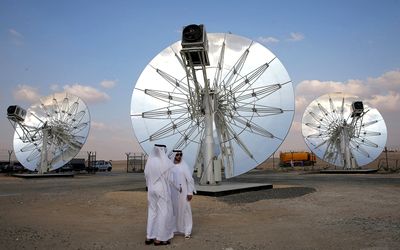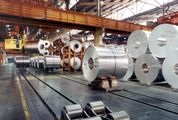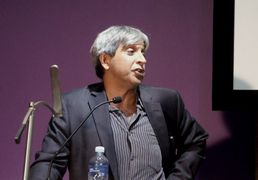FACED with the double challenge of balancing their energy supply against the needs of growing populations and maintaining growth at a minimum cost to the environment, many countries are increasingly looking for sustainable energy sources.
According to the International Energy Agency’s World Energy Outlook published last year, by 2040 nearly half of the world’s electricity will be generated through low-carbon technologies. The fast-growing economies of the Middle East are no exception to this trend, with the United Arab Emirates, Saudi Arabia, Jordan and other countries making the first steps towards switching away from hydrocarbons.
One dilemma these countries almost inevitably face is the choice between the various options in their energy portfolio.
Nuclear and renewable would seem the frontrunners; both are quite widespread globally, including the Middle East, and have supporters and detractors.
The Middle East, where nuclear development is rapidly taking hold and where wind and solar resources abound all year, would seem uniquely placed to compare the relative uses and efficiency of nuclear and renewable energy in meeting the region’s needs.
But many energy experts argue that examining nuclear and renewable energy as a dichotomy does not take into account the very different nature (and vagaries) of these technologies. Perhaps the best way to view nuclear and renewable energy is through the crucial concept underlying the functioning of modern economies with regard to power — baseload, the minimum level of demand on an electrical supply system over 24 hours, required for industries to operate properly all the time, without blackouts that can result in damage worth billions of dollars.
Baseload has to be reliable and predictable, and needs a stable source of power. That is where renewable energy falls short.
To compare nuclear and renewable energy in a winner-takes-all scenario is naive and incorrect.
Both have their place in the energy mix because they offer different benefits.
Renewables, while a good supplement to the energy required to run an economy, aren’t reliable enough to provide more than a fraction of baseload power.
So-called backup capacity, such as gas, actually provides more energy than the renewables.
Backup capacity is also required when wind and solar systems produce nothing or next to nothing — which is not uncommon.
Renewable energy is notoriously unreliable: the output is linked to weather conditions and other external factors, which is why it is often referred to as intermittent power. Even in countries that enjoy plenty of sun and wind throughout the year, wind can achieve a net capacity factor of only about 25% and photovoltaic solar is even less at only 20%, while newer generation nuclear power plants now achieve a net capacity factor of more than 92%.
Capacity factor is how much electricity a power plant actually produces compared to how much it would produce if it operated at full capacity 100% of the time.
According to the report, The Net Benefits of Low and No-Carbon Electricity Technologies, published by the Brookings Institution in 2014, solar and wind facilities have a very high capacity cost per megawatt, very low capacity factors and low reliability, which result in low avoided emissions and low avoided energy cost per dollar invested.
Expensive to install and with a relatively short service life, they require substantial government subsidies to provide significant power output, which cannot be stored economically.
The power derived from renewable energy is too expensive per kilowatt-hour to be competitive, especially when compared to the electricity prices made possible by the latest technological offerings from global nuclear players such as China, South Korea and Russia.
Huge demand for baseload power also means considerable stress on the environment. The only feasible alternative to nuclear is coal, which would undermine the commitments SA and the rest of the world made at the recent Conference of the Parties conference in Paris.
Germany’s decision to abandon nuclear power led to an annual increase in CO² emissions of 28-million tonnes. The cost of replacing nuclear power with wind and solar is estimated at more than €3-trillion, with no guarantee that this will help reduce carbon emissions.
Nuclear also has the edge in agility and adjustability — renewable energy facilities cannot be switched on and off to follow demand.
Nuclear power plants can remain online and reduce or increase their power outputs.
The nuclear investments in the Middle East are proof of its competitive potential for the region. Even in the most perfect environments, solar power still isn’t competitive with nuclear — or as effective.
However, renewable energy has a place in the energy mix of an economy focused on growth and development. While peak power remains more expensive per kilowatt-hour than baseload, it is necessary to satisfy the demand for electricity when it is at its highest.
Solar energy in particular can go some way towards meeting that peak demand as sunny afternoon hours more or less coincide with peak times for the load on the power grids.
The competition between nuclear and renewable energy should not exist in the first place.
Both are cleaner than hydrocarbon-based energy sources, and both have applications that are meant to complement each other. This is outlined in SA’s Integrated Resource Plan.
Nuclear has the capacity to efficiently supply baseload power; renewables supplement demand for peak power when needed.
• Blees is president of the Science Council for Global Initiatives and a member of the selection committee for the Global Energy Prize

Middle Eastern countries are turning away from using hydrocarbons for electricity and are looking at solar and nuclear energy. Picture: REUTERS
FACED with the double challenge of balancing their energy supply against the needs of growing populations and maintaining growth at a minimum cost to the environment, many countries are increasingly looking for sustainable energy sources.
According to the International Energy Agency’s World Energy Outlook published last year, by 2040 nearly half of the world’s electricity will be generated through low-carbon technologies. The fast-growing economies of the Middle East are no exception to this trend, with the United Arab Emirates, Saudi Arabia, Jordan and other countries making the first steps towards switching away from hydrocarbons.
One dilemma these countries almost inevitably face is the choice between the various options in their energy portfolio.
Nuclear and renewable would seem the frontrunners; both are quite widespread globally, including the Middle East, and have supporters and detractors.
The Middle East, where nuclear development is rapidly taking hold and where wind and solar resources abound all year, would seem uniquely placed to compare the relative uses and efficiency of nuclear and renewable energy in meeting the region’s needs.
But many energy experts argue that examining nuclear and renewable energy as a dichotomy does not take into account the very different nature (and vagaries) of these technologies. Perhaps the best way to view nuclear and renewable energy is through the crucial concept underlying the functioning of modern economies with regard to power — baseload, the minimum level of demand on an electrical supply system over 24 hours, required for industries to operate properly all the time, without blackouts that can result in damage worth billions of dollars.
Baseload has to be reliable and predictable, and needs a stable source of power. That is where renewable energy falls short.
To compare nuclear and renewable energy in a winner-takes-all scenario is naive and incorrect.
Both have their place in the energy mix because they offer different benefits.
Renewables, while a good supplement to the energy required to run an economy, aren’t reliable enough to provide more than a fraction of baseload power.
So-called backup capacity, such as gas, actually provides more energy than the renewables.
Backup capacity is also required when wind and solar systems produce nothing or next to nothing — which is not uncommon.
Renewable energy is notoriously unreliable: the output is linked to weather conditions and other external factors, which is why it is often referred to as intermittent power. Even in countries that enjoy plenty of sun and wind throughout the year, wind can achieve a net capacity factor of only about 25% and photovoltaic solar is even less at only 20%, while newer generation nuclear power plants now achieve a net capacity factor of more than 92%.
Capacity factor is how much electricity a power plant actually produces compared to how much it would produce if it operated at full capacity 100% of the time.
According to the report, The Net Benefits of Low and No-Carbon Electricity Technologies, published by the Brookings Institution in 2014, solar and wind facilities have a very high capacity cost per megawatt, very low capacity factors and low reliability, which result in low avoided emissions and low avoided energy cost per dollar invested.
Expensive to install and with a relatively short service life, they require substantial government subsidies to provide significant power output, which cannot be stored economically.
The power derived from renewable energy is too expensive per kilowatt-hour to be competitive, especially when compared to the electricity prices made possible by the latest technological offerings from global nuclear players such as China, South Korea and Russia.
Huge demand for baseload power also means considerable stress on the environment. The only feasible alternative to nuclear is coal, which would undermine the commitments SA and the rest of the world made at the recent Conference of the Parties conference in Paris.
Germany’s decision to abandon nuclear power led to an annual increase in CO² emissions of 28-million tonnes. The cost of replacing nuclear power with wind and solar is estimated at more than €3-trillion, with no guarantee that this will help reduce carbon emissions.
Nuclear also has the edge in agility and adjustability — renewable energy facilities cannot be switched on and off to follow demand.
Nuclear power plants can remain online and reduce or increase their power outputs.
The nuclear investments in the Middle East are proof of its competitive potential for the region. Even in the most perfect environments, solar power still isn’t competitive with nuclear — or as effective.
However, renewable energy has a place in the energy mix of an economy focused on growth and development. While peak power remains more expensive per kilowatt-hour than baseload, it is necessary to satisfy the demand for electricity when it is at its highest.
Solar energy in particular can go some way towards meeting that peak demand as sunny afternoon hours more or less coincide with peak times for the load on the power grids.
The competition between nuclear and renewable energy should not exist in the first place.
Both are cleaner than hydrocarbon-based energy sources, and both have applications that are meant to complement each other. This is outlined in SA’s Integrated Resource Plan.
Nuclear has the capacity to efficiently supply baseload power; renewables supplement demand for peak power when needed.
• Blees is president of the Science Council for Global Initiatives and a member of the selection committee for the Global Energy Prize























Change: 1.19%
Change: 1.36%
Change: 2.19%
Change: 1.49%
Change: -0.77%
Data supplied by Profile Data
Change: -0.08%
Change: 0.12%
Change: 1.19%
Change: 0.00%
Change: 0.10%
Data supplied by Profile Data
Change: 0.32%
Change: 0.43%
Change: 0.41%
Change: 0.22%
Change: 0.58%
Data supplied by Profile Data
Change: 0.12%
Change: -0.41%
Change: 0.00%
Change: -0.33%
Change: 0.10%
Data supplied by Profile Data